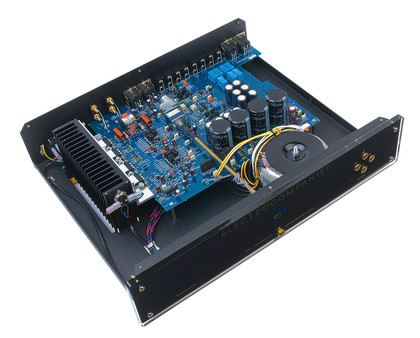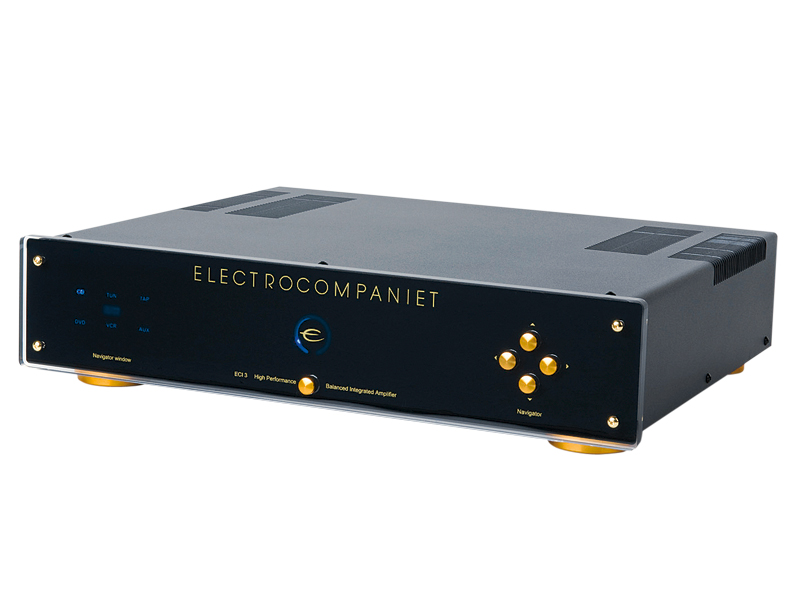TechRadar Verdict
Taste cannot be ignored when it comes to sound quality and we like the calm, clean presentation of this amp enough to forgive its relative lack of midband sparkle. The fact that it's so revealing is the key to its addictive musicality
Pros
- +
A highly revealing and powerful amplifier
- +
Extremely well built and finished
- +
Fully balanced operation - a rarity at this price
Cons
- -
The slightly dark mid/top won't be to all tastes
- -
Front panel operation is willfully obscure to the uninitiated
Why you can trust TechRadar
Electrocompaniet is far from yesterday's news going by the launch of its thrilling new ECI-3 integrated amplifier.
The company has been making serious hi-fi for well over forty years and used to have a high profile in the UK, something it appears to be trying to re-establish now.
It makes a substantial range of largely two-channel equipment for both domestic and professional markets.
The classic range – of which the ECI-3 is the most affordable amplifier – has no fewer than five CD players, two integrated amps, three preamps, three stereo and three monoblock power amps, and a phono stage!
That's a substantial range – and it's not the only one in the portfolio. It's got to be one of the largest product ranges we've seen in the two-channel arena for some time.
Electrocompaniet claims that this amp is built with the same quality components as its most prestigious models – presumably there are fewer of them as this is also the least powerful amp on the roster.
Electrocompaniet prides itself in fully balanced, DC coupled operation, so this integrated amp has XLR in and outputs to make full use of the balanced circuitry. Balanced configuration is usually chosen because it has the potential to result in lower noise, something that's not always apparent in domestic set-ups where you don't tend to use miles of cabling.
The front panel has a distinctive appearance, devoid of knobs. With a mere five buttons it is both minimalist and initially confusing. However, it's actually intuitive: when the light on the motorised volume pot behind the panel moves, you know that you've found the north/south volume buttons, for example.
The west/east buttons change input, illuminating names in the 'navigator window' on the left of the facia as the relays click. A relatively conventional multiproduct remote is also supplied, adding mute to the small roster of functions, effectively putting the amp into standby.
Inside the substantial acrylic-fronted box, one of Electrocompaniet's floating transformer technology power supplies can be found. This is said to be capable of delivering twice as much current as conventional designs.
The company backs this up by stating that, as with all of its amps, the ECI-3 is stable into loads down to half an ohm. This isn't something that you'd expect it to have to deal with – even the most challenging speakers rarely drop below an ohm – but it's reassuring nonetheless.

The back panel is pretty straightforward. There's a row of RCA phono inputs and outputs beside balanced versions of the same. You don't get a unity gain input for home cinema systems and neither is there a bus system or software upgrade port, however.
Compare this set-up with the Arcam A38, for example: it has two sets of speaker terminals, a space for optional phono stage, a 12v trigger, remote socket and so on – all of which have to come out of a similar budget. Maybe this is why Electrocompaniet can afford to incorporate fully balanced operation in the ECI-3?
Sound quality
Electrocompaniet is keen that its amplifiers should be used with a source that's capable of delivering a true balanced output and suggested that we use one of its own CD players for the test. This was tempting, but would have complicated the review process.
Instead, we elected to use Leema's Antila II. Out of interest, the single-ended and balanced inputs of the amp were both hooked up to the Antila II with suitably terminated DNM reson cables and compared. The difference was not all that obvious to be frank, but we used the balanced connection for all the non- Detail comparative listening nonetheless.
Noise is notably low with the ECI-3, which makes us wonder if that balanced connection does make a difference after all. Our Keith Jarrett Carnegie Hall disc didn't seem to give up all of its reverberant detail, for example, but you can hear a long way down into the mix.
High frequencies are not only a little darker than usual, but also extremely clean: the right hand piano keys come through in a truly shimmering fashion that's highly convincing.
Our next disc – Cougar's fine Patriot album – revealed impressive depth of image against a backdrop that can only be described with the immortal phrase 'inky blackness' – it's that quiet, alright. Here the cymbal tone is very natural, if not as harmonically rich as usual. Still, it's very convincing and makes a good case for suggesting that other amps add some high-frequency haze of their own.
The heavier riffs of the album are dealt with in a calm and yet fully bone-crunching fashion that encourages one to turn up the wick, but the real revelations come with the better acoustic recordings. András Schiff's Beethoven Piano Sonatas, for example, provide plentiful reverb, attack and dynamic vitality alongside tremendous delicacy in the slower passages.

POWER TOWER: The power supply dominates the front right of the amp, with the input selections sitting just behind
As the Electrocompaniet is about the same price as an Arcam A38, albeit with fewer features, we dug one out of the store cupboard to see how it would fare. Impressively, the results suggested that we could have a new benchmark – the ECI-3 proving to be significantly more precise and calm compared with the louder, livelier and rather busy Arcam.
Both amplifiers have similar timing qualities, with no undue emphasis on leading edges, but the Electrocompaniet's precise midband removes much of the haziness to leave a cleaner musical phrase. This makes long-term listening a more pleasurable experience.
There is also impressive grip on tap for a 70-watt amplifier (it would seem that Electrocompaniet's approach to power supply design has paid off when it comes to controlling the loudspeaker).
Double bass has real texture and weight, yet remains nimble and on the ball. it also makes for very clear-cut imaging: on a spin of our Gillian Welch test disc, she is placed left of stage with her guitar while her cohort is on the right. This may not sound all that impressive, but usually the two are melded together in the centre and the playing cannot be easily separated.
Bringing in PMC's PB1i speaker in place of our Bowers and Wilkins 802D reveals that the transmission line-loaded PMC's balance is rather better suited to this amplifier's character.
The PB1i has a very open midband and this works rather well with the slightly dark character of the ECI-3, the pairing turning in a highly revealing and engaging sound with a variety of discs – one that makes alternative amps sound positively veiled.
If this model is anything to go by, Electrocompaniet's return to the UK is long overdue. This is an impressively resolute and powerful integrated amp for the money.
Follow TechRadar Reviews on Twitter: http://twitter.com/techradarreview
